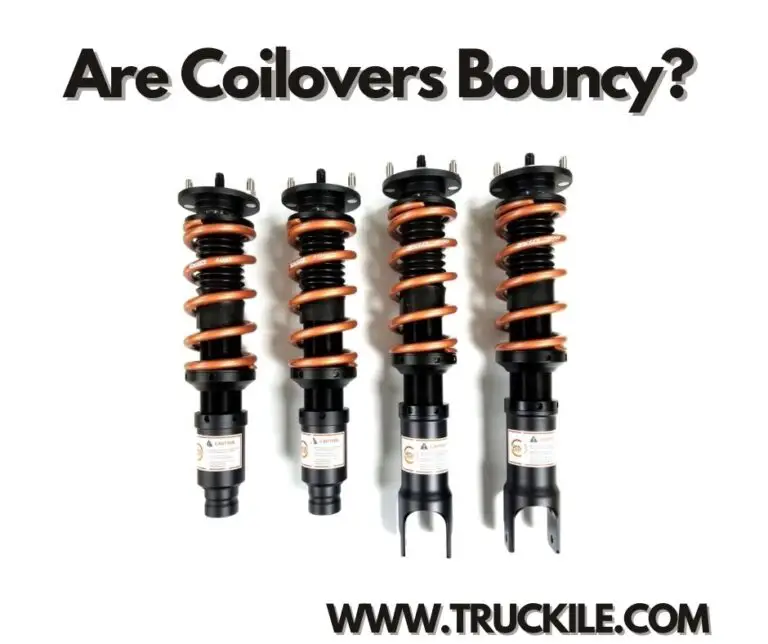What’s The Difference Between Air Shocks And Airbags?
You may have found air shocks and airbags in your vehicle, but you’re not sure what the difference is. The reality is, shock absorbers and airbags are different technologies that serve a similar purpose.
Without further words, let’s look into the crux, what’s the difference between air shocks and airbags?
What’s The Difference Between Air Shocks And Airbags?
Air shocks are simple devices: they’re just like a standard shock absorber except that the compressed air inside can be used to support some of the weight of the vehicle. They’re still used in conjunction with a mechanical spring, which provides most of the support for the weight.
Air bags are designed to support weight; they are not designed to absorb energy (as shock absorbers do). For this reason, an air suspension system needs either an additional shock absorber or other means of controlling wheel movement once it has been displaced by a bump in the road.
Do You Need Shocks With Air Bags?
Here’s someone’s words:
I’m sure you’ve heard a lot about air shocks and how they work better on your vehicle. I’m also sure that you wondered why air shocks are so much more money than the regular shock absorber?
Air shocks are designed to give a firmer ride than a standard shock absorber. They are designed to keep the vehicle at a higher ride height especially when loaded, and they level out side to side lean. This can be very helpful in the event you are hauling heavy loads, or have an RV or horse trailer with you.
If you have leaf springs or coil springs on your vehicle they will work just fine with or without air shocks, but if you have air suspension like many of today’s cars trucks and vans then it is recommended that you use air shock absorbers because the pneumatic system will not be able to properly compensate for the stiffness of a standard shock absorber which might cause instability and a stiff ride.
Do Air Bags Replace Shocks?
Once reserved only for luxury cars and heavy-duty trucks, air suspension systems are coming into their own today, with more and more vehicles being equipped with them. These systems replace the traditional shock/strut/spring setup with a series of air bags.
Air bags use an onboard compressor to inflate or deflate the bags as needed, changing the height of your vehicle. This allows for a wide range of ride quality adjustments based on the terrain you’re driving over.
The primary benefit of air suspension is that it allows you to adjust your vehicle’s ride height on demand. This can be especially useful if you’re hauling a heavy load because it will allow you to level out your vehicle and minimize swaying or bottoming out. You can also raise or lower your car as needed to get through certain types of road hazards.
Air suspensions also have some additional benefits that make them worth considering. The same technology that allows them to change ride height also allows them to adapt their firmness on the fly, which can help improve driving comfort in both highway and off-road situations. They also give your car a smoother ride overall, which tends to improve gas mileage.
GFHTYJYUKYK
Let us start by saying that we have no idea what kind of truck you have. If it’s a Chevy, Dodge or Ford they all have different front ends and different designs. When air shocks first came out they were a novelty item and most people didn’t know any better. Now that trucks are more stylish, the manufacturers are designing them to sit lower to the ground.
Our advice is to never use air shocks in the front of your truck unless you want to spend a lot of money on repairs after you destroy expensive parts like ball joints and tie rods. Air shocks are for the rear end only, where they don’t affect your vehicle’s handling.
If you want to lift your truck, get a real kit with springs and lift blocks — it will be much safer and last longer. Also, with a real lift kit, you’ll need new, longer brake lines and brake hoses. You can get those from your local auto parts store.
Don’t forget that once you lift your truck, it may not handle as well and will be less stable at high speeds. This is something you should take into account before starting your project.
Is It Worth Getting Air Suspension?
Ride Quality – Converting your shocks, struts, and coil springs to an air suspension setup allows for a better ride quality due to the design of the air shock. Air shocks make for a comfortable and softer ride quality that is leagues ahead of your factory suspension setup.
Air Suspension Adjustability – The ability to adjust your ride height on demand is a huge benefit of going with an air-ride suspension setup.
If you like the look of a slammed lowrider (whether it be a truck or car) then an air suspension system is the way to go. You can raise and lower your car at will.
Another benefit would be when driving in snowy conditions you can raise your vehicle up to get over any snow or ice on the road. The bottom line when it comes to getting an air suspension kit is adjustability.
Air Suspension Kits Are Safer – When driving down the road, regardless if you are in a car or truck, hitting potholes can cause damage to your vehicle’s suspension components.
Air shocks have the advantage over standard hydraulic shocks due to their ability to absorb bumps while driving down the road. This feature makes owning an air suspension kit much safer than having traditional coil springs and shock absorbers.
Can You Put Air Shocks On The Front Of A Car?
Some vehicles were designed with air shocks from the factory, but if you want to change your factory suspension to air, there are kits available to accomplish that. You can do this by installing both bags on one axle, or you can add a set of air shocks for both axles. Either way, if you want to be able to adjust your ride height, you need an air compressor and a tank.
Air springs will not replace the shock absorbers in your vehicle. They should be used in conjunction with your existing shocks, which provide damping control, and work together to give you the best possible ride quality.
Which Is Better Air Shocks Or Air Bags?
Air shocks are a great way to get more load capacity out of your existing suspension. By adding air pressure to your factory shocks, you can significantly increase the amount of weight that your vehicle can carry. They are easy to use and inexpensive.
Air shocks are an excellent choice for anyone who wants to haul a lot of weight on their vehicle: boats, trailers, cargo, heavy machinery, etc. The main benefit of air shocks is that they allow you to adjust the amount of suspension depending on the load.
This means you can haul more without sacrificing ride quality or safety. With just one simple adjustment you can go from hauling 500 pounds to 1000!
Air bags also have many benefits over regular leaf springs. They provide a smoother ride than leaf springs because they absorb bumps in the road better than leaf springs do. Also, they are not affected by corrosion or rust like traditional steel springs would be.
Air bags do not require any maintenance after installation other than checking pressure levels every now and then; even then it’s only necessary if there’s been significant changes in your vehicle’s weight distribution since installation took place.
What’s The Difference Between Air Shocks And Airbags – Conclusion
As a recap of the response we gave to the question, What’s The Difference Between Air Shocks And Airbags?
Air shocks are simple devices: they’re just like a standard shock absorber except that the compressed air inside can be used to support some of the weight of the vehicle. They’re still used in conjunction with a mechanical spring, which provides most of the support for the weight.
Air bags are designed to support weight; they are not designed to absorb energy (as shock absorbers do). For this reason, an air suspension system needs either an additional shock absorber or other means of controlling wheel movement once it has been displaced by a bump in the road.
Thanks for reading.

Joe lives and breathes cars and trucks. After many years working in the Auto industry, he decided that it is only right to share his knowledge with the public. As a qualified expert in trucks and cars, he started working for Truckile.com and is the main editor and publisher.






